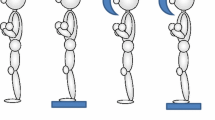Abstract
The capability for the unconscious control of the upright posture in elderly people is impaired, which increases the risk of falls and traumata. The impairment of the unconscious control of posture is partially compensated by the fixation of voluntary attention on the maintenance of an appropriate posture. Elderly people fall predominantly during the performance of movements that demand additional voluntary postural control, for example, unstable support conditions. Thus, voluntary postural control assumes importance in elderly persons. Since it is unclear whether this function changes with age, the aim of this work was to study age-related features of the learning voluntary postural control using visual feedback by center-of-pressure position. The results of the study showed that voluntary postural control is a complex multicomponent process that includes, at least, the following functions: selection of a strategy of postural control, its actualization, and precision of its regulation. With aging, strategy selection in healthy people impairs, but both elderly and middle-aged people can learn this function as successfully as the young. At the same time, despite the absence of an initial deficit in the accuracy of postural setting in elderly people, training of this function becomes substantially more difficult with age.
Similar content being viewed by others
REFERENCES
Horak, F.B., Shupert, C.L., and Mirka, A., Components of Postural Dyscontrol in the Elderly: A review, Neurobiol. Aging, 1989, vol. 10, p. 727.
Manchester, D., Woollacott, M.N., Zederbauer-Hylton, N., and Marino, O., Visual, Vestibular and Somatosensory Control in the Older Adult, J. Gerontol., 1989, vol. 44, p. 118.
Maki, B.E., Holiday, P.J., and Topper, A.K., Fear of Fall-ing and Postural Performance in the Elderly, J. Geron-tol., 1991, vol. 46, p. 123.
Tinetti, M.E. and Powel, L., Fear of Falling and Low Self-efficacy: A Case of Dependence in Elderly Persons, J. Gerontol., 1993, vol. 48, p. 35.
Gabell, A. and Nayak, U., The Effect of Age on Variabil-ity of Gait, J. Gerontol., 1985, vol. 16, p. 79.
Melzer, I., Benjuya, N., and Kaplanski, J., Age Related Changes in Muscle Strength and Fatigue, Isokinetics and Exercise Science, 2000, vol. 8, p. 73.
Vandervoort, A.A. and Hayes, K.C., Plantarflexor Mus cle Function in Young and Elderly Woman, J. Appl. Physiol., 1989, vol. 58, p. 389.
King, M.B., Judge, J.O., and Wolfson, L., Functional Base of Support Decrease with Age, J. Gerontol., 1994, vol. 49, p. 253.
Lord, S.R., Sambrook, P.N., Gilbert, C., et al., Postural Stability, Falls and Fractures in the Elderly: Results from the Dubbo Osteoporosis Epidemiology Study, Med. J. Austr., 1994, vol. 160, p. 684.
Alexander, N., Progress in Geriatrics: Gait Disorders in Older Adults, J. Am. Geriatr. Soc., 1996, vol. 44, p. 434.
Teasdale, N., Stelmach, G.E., and Breuning, A., Postural Sway Characteristics of the Elderly under Normal and Altered Visual and Support Surface Conditions, J. Ger ontol., 1991, vol. 46, p. 238.
Shumway-Cook, A., Woollacott, M., Baldwin, M., and Kerns, K., The Effects of Cognitive Demands on Pos tural Control in Elderly Fallers and Nonfallers, J. Geron-tol., 1997, vol. 52, p. 232.
Brown, L., Shumway-Cook, A., and Woollacott, M., Attentional Demands and Postural Recovery: The Effect of Aging, J. Gerontol., 1999, vol. 54, p. 165.
Woollacott, M. and Shumway-Cook, A., Decreased Sta bility in the Elderly: Are Cognitive Influences Contribut-ing Factors?, in Control of Posture and Gait, Maastricht, 2001, p. 175.
Shumway-Cook, A. and Woollacott, M., Motor Control: Theory and Practical Applications, Baltimore: Lippin cott Williams & Wilkins, 2000.
Teasdale, N., Bard, C., LaRue, J., and Fleury, M., On the Cognitive Penetrability of Postural Control, Exp. Aging Res., 1993, vol. 19, p. 1.
Ioffe, M.E., Mekhanizmy dvigatel'nogo obucheniya (Mechanisms of Motor Learning), Moscow: Nauka, 1991.
Author information
Authors and Affiliations
Rights and permissions
About this article
Cite this article
Ustinova, K.I., Ioffe, M.E. & Chernikova, L.A. Age-Related Features of the Voluntary Control of the Upright Posture. Human Physiology 29, 724–728 (2003). https://doi.org/10.1023/B:HUMP.0000008845.17747.e8
Issue Date:
DOI: https://doi.org/10.1023/B:HUMP.0000008845.17747.e8




